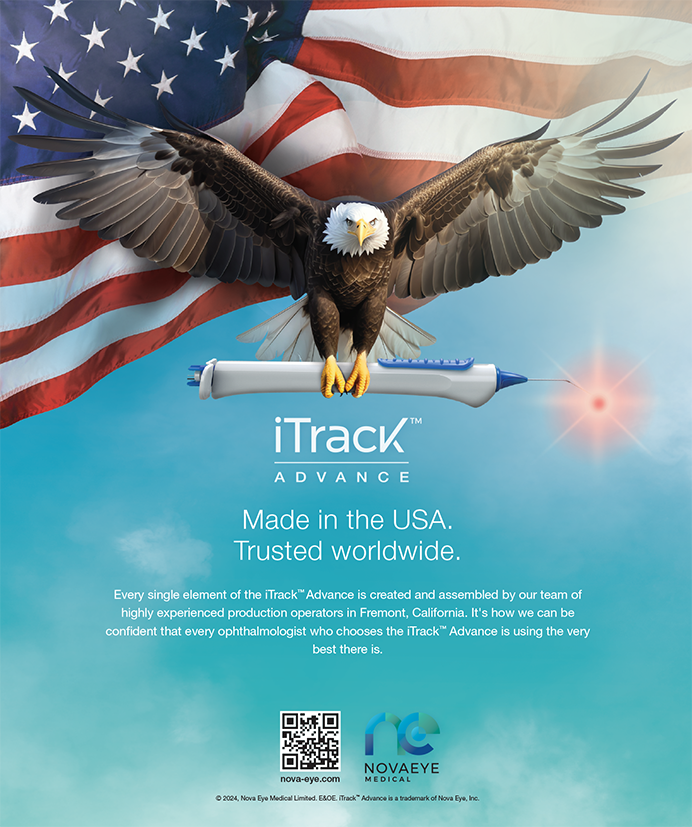
Customized Corneal Cross-linking: One-Year Results
Seiler TG, Fischinger I, Koller T, et al1
ABSTRACT
In a prospective 1-year clinical trial, Seiler and colleagues compared the efficacy of customized corneal collagen cross-linking (CXL) with standard epithelium-off CXL. Conducted at the Institut für Refraktive und Ophthalmo-Chirugie in Zurich, Switzerland, the study included 40 eyes of 40 patients with progressive primary keratoconus (defined by the investigators as an increase in maximal corneal curvature [ie, Kmax] of at least 1.00 D within 1 year as measured by corneal tomography with the Pentacam [Oculus Surgical]).
AT A GLANCE
• A review of results 1 year after customized corneal collagen cross-linking (CXL) in patients with progressive primary keratoconus found that customized CXL is as safe as standard CXL. It also found that customized CXL has a faster epithelial healing time and produces significantly more flattening of maximal corneal curvature and the regularization index.
• Computational modeling of patterned applications of ultraviolet light in CXL of healthy eyes determined that a linear bowtie pattern provides the largest magnitude of correction of corneal astigmatism.
• In a case report, toric, topographically customized, transepithelial CXL achieved positive results while also reducing astigmatic error and improving distance UCVA in a patient with keratoconus.
The control group of 20 patients underwent a standard epithelium-off CXL procedure with a 9-mm epithelial debridement, an application of 0.1% riboflavin for 30 minutes, and diffuse corneal irradiation with 9 mW/cm2 for 10 minutes (total energy of 5.4 J/cm2). The 20 patients in the customized CXL group were treated using a smaller eccentric area of epithelial debridement centered on the maximum of the posterior float (theorized to be the weakest point of the cornea) and a customized, varied, ultraviolet (UV) irradiation divided into zones based on the diameter of the posterior float. The inner circular zone (1.9-2.9 mm) received a radiance exposure of 10 J/cm2, the middle zone 7.5 J/ cm2, and the outer zone (5.2-6.5 mm) 5.4 J/cm2. Both groups were treated with antibiotic ointment and a bandage contact lens until the epithelial defect healed, after which treatment with topical fluorometholone commenced.
In each study group, 19 of the 20 patients completed the 1 year of follow-up when pre- and postoperative Schleimpflug tomography, endothelial cell counts, BSCVA, and anterior segment optical coherence tomography were compared. The customized CXL group had a statistically significantly faster epithelial healing time than the standard CXL group (2.56 ±0.50 vs 3.19 ±0.73 days). In seven of 19 eyes (37%) in the customized CXL group, Kmax decreased by more than 2.00 D compared with two of 19 eyes (11%) in the standard group.
The researchers also introduced a new term, the regularization index (RI), which they define as the maximal steepening plus the maximal flattening on the corneal tomography difference map 1 year postoperatively compared to preoperatively. They found that the RI in the customized CXL group was 5.20 ±2.70 D compared to 4.10 ±3.10 D in the control group. Seiler and colleagues concluded that customized CXL is as safe as standard CXL with significantly more flattening of Kmax and RI as well as a faster epithelial healing time.
DISCUSSION
These 1-year data show that customized CXL is superior to standard CXL for regularizing the corneal tomography and that the two procedures are equally safe for progressive keratoconus. Because the cornea is at risk of infection and other sight-threatening complications during epithelial healing,2 minimizing epithelial healing time via customized CXL may be advantageous.
Of note, one patient in the customized CXL group showed progression of keratoconus, with corneal steepening occurring just outside the treatment zone. The investigators attributed this incident to unintentional decentration of the treatment zones and called for future optimization of customized CXL using larger treatment zones and technology such as Brillouin spectroscopy, which allows for reliable biomechanical measurements of the weakest point of the cornea.3
Other studies have suggested customized CXL as a refractive procedure,4,5> but this study does not report a significant difference in BSCVA between the two groups. Further studies with more treated eyes and longer follow-up are needed to make customized CXL the new standard.
Patterned Corneal Collagen Crosslinking for Astigmatism: Computational Modeling Study
Seven I, Roy AS, Dupps WJ Jr4
ABSTRACT
The aim of this computational modeling study of 10 patients with corneal astigmatism was to show that the customized, patterned application of UV light in CXL may be used as an alternative refractive procedure to reduce astigmatism. This study included various severity levels and patterns of astigmatism (1.22-3.92 D) and excluded eyes with a history of surgery or keratoconus. Three-dimensional corneal data were exported from a clinical Pentacam corneal tomography system, and corneoscleral finite element models were generated for analysis. Assumed two-time corneal stiffening after CXL was simulated for four treatment patterns (rounded bowtie, butterfly, center-sparing butterfly, and linear bowtie), which were oriented along the flat axis. The investigators calculated pre- and posttreatment simulated keratometry values and lower-order as well as third-order aberrations.
The models showed a statistically significant reduction in corneal astigmatism in each of the four treatment patterns, but the largest magnitude of correction (mean reduction of 1.08 D) was achieved with the linear bowtie pattern.
DISCUSSION
The investigators proposed the use of patterned CXL as an alternative treatment for refractive error, specifically astigmatism, in healthy eyes. The researchers explained that the basis of their theory depends on the fact that CXL’s stiffening effect does not occur with the application of riboflavin alone, which diffuses throughout corneal tissue during the procedure, but requires the addition of UVA light, which can be applied in a selective pattern to cause only focal stiffening and thereby correct astigmatism.4 This concept of corneal stiffening along the flat axis to treat astigmatism is novel compared with current methods of treating the steep axis using corneal relaxing incisions.
The investigators’ computational models tested several patterns of selective corneal stiffening and found that the linear bowtie pattern attained the greatest reduction in astigmatism. The long-term refractive stability of this unique patterned application of CXL in eyes without keratoconus must be investigated before it may be approved and marketed as a refractive procedure for astigmatic correction. This study sets up a model for these future in vivo studies and suggests that patterned CXL treatment could serve as an alternative refractive treatment in select patients.
Toric Topographically Customized Transepithelial, Pulsed, Very High-Fluence, Higher Energy and Higher Riboflavin Concentration Collagen Cross-linking in Keratoconus
Kanellopoulos AJ, Dupps WJ, Seven I, Asimellis G5
ABSTRACT
Kanellopoulos and colleagues reported using a topographically guided, transepithelial cross-linking technique to treat both corneal ectasia and irregular astigmatism in a 37-year-old woman with progressive keratoconus. The patient underwent epithelium-on CXL with a two-step application of riboflavin (0.25% riboflavin solution with 0.02% benzalkonium chloride over 4 minutes followed by 0.25% riboflavin isotonic saline solution for 6 minutes). UVA irradiation was then applied in two patterns: (1) a toric butterfly wing pattern oriented orthogonally to the steep axis of astigmatism at a total energy of 14 J/cm2 for 10 minutes and 22 seconds and (2) a 6-mm diffuse circular irradiation pattern at 4 J/cm2 applied for 2 minutes and 56 seconds.
The patient’s distance UCVA improved from 20/40 preoperatively to 20/25 6 months postoperatively, without epithelial haze or surgical complications. The investigators also reported a significant reduction (1.40 D) in astigmatic error and a trend toward normalization of the corneal curvature postoperatively.
DISCUSSION
This case report demonstrates that novel customized CXL treatments may be applied to keratoconic corneas to reduce astigmatism and improve distance UCVA. The investigators suggested that the refractive effect was from direct stromal remodeling, because any epithelial changes normalized after 6 months.
Citing the ease of treatment and the patient’s recovery as advantages, the researchers did use epithelium-on or transepithelial CXL in the case study. This CXL method is considered investigational in the United States at this time, and the efficacy of epithelium-off versus transepithelial CXL continues to be a controversial subject.6,7 Some smaller-scale studies have reported equivalent results using epithelium-off versus transepithelial CXL.8,9 Studies are underway to determine the long-term stability of epithelium-on CXL, and further reports on the longevity of customized epithelium-on CXL are necessary.
1. Seiler TG, Fischinger I, Koller T, et al. Customized corneal cross-linking: one-year results. Am J Ophthalmol. 2016;166:14-21.
2. Koller T, Mrochen M, Seiler T. Complication and failure rates after corneal crosslinking. J Cataract Refract Surg. 2009;35(8):1358-1362.
3. Scarcelli G, Besner S, Pineda R, et al. In vivo biomechanical mapping of normal and keratoconus corneas. JAMA Ophthalmol. 2015;133(4):480-482.
4. Seven I, Sinha Roy A, Dupps WJ Jr. Patterned corneal collagen crosslinking for astigmatism: computational modeling study. J Cataract Refract Surg. 2014;40(6):943-953.
5. Kanellopoulos AJ, Dupps WJ, Seven I, Asimellis G. Toric topographically customized transepithelial, pulsed, very high-fluence, higher energy and higher riboflavin concentration collagen cross-linking in keratoconus. Case Rep Ophthalmol. 2014;5(2):172-180.
6. Rush SW, Rush RB. Epithelium-off versus transepithelial corneal collagen crosslinking for progressive corneal ectasia: a randomised and controlled trial [published online ahead of print July 7, 2016]. Br J Ophthalmol. 2016 Jul 7. doi:10.1136/bjophthalmol-2016-308914.
7. Bikbova G, Bikbov M. Standard corneal collagen crosslinking versus transepithelial iontophoresis-assisted corneal crosslinking, 24 months follow-up: randomized control trial [published online ahead of print April 4, 2016]. Acta Ophthalmol. doi:10.1111/aos.13032.
8. Rossi S, Orrico A, Santamaria C, et al. Standard versus trans-epithelial collagen cross-linking in keratoconus patients suitable for standard collagen cross-linking. Clin Ophthalmol. 2015;9:503-509.
9. De Bernardo M, Capasso L, Tortori A, et al. Trans epithelial corneal collagen crosslinking for progressive keratoconus: 6 months follow up. Cont Lens Anterior Eye. 2014;37(6):438-441.




